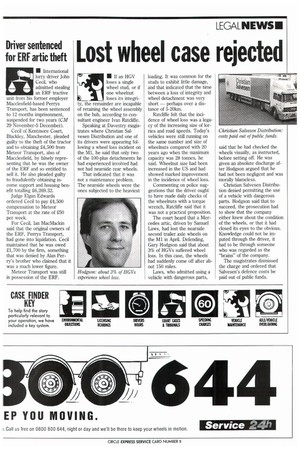Lost wheel case rejected
Page 13

If you've noticed an error in this article please click here to report it so we can fix it.
• If an HGV loses a single wheel stud, or if one wheelnut loses its integrity, the remainder are incapable of retaining the wheel assembly on the hub, according to consultant engineer Ivan Ratcliffe.
Speaking at Daventry magistrates where Christian Salvesen Distribution and one of its drivers were appearing following a wheel loss incident on the Ml, he said that only two of the 100-plus detachments he had experienced involved had not had nearside rear wheels.
That indicated that it was not a maintenance problem. The nearside wheels were the ones subjected to the heaviest loading. It was common for the studs to exhibit little damage, and that indicated that the time between a loss of integrity and wheel detachment was very short — perhaps over a distance of 5-20km.
Ratcliffe felt that the incidence of wheel loss was a legacy of the increasing size of lorries and road speeds. Today's vehicles were still running on the same number and size of wheelnuts compared with 20 years ago when the maximum capacity was 28 tonnes, he said. Wheelnut size had been increased in the US and had showed marked improvement in the incidence of wheel loss.
Commenting on police suggestions that the driver ought to have made daily checks of the wheelnuts with a torque wrench, Ratcliffe said that it was not a practical proposition.
The court heard that a Mercedes artic, driven by Samuel Laws, had lost the nearside second trailer axle wheels on the M1 in April. Defending, Gary Hodgson said that about 3% of HGVs suffered wheel loss. In this case, the wheels had suddenly come off after about 150 miles.
Laws, who admitted using a vehicle with dangerous parts, said that he had checked the wheels visually, as instructed, before setting off. He was given an absolute discharge after Hodgson argued that he had not been negligent and was morally blameless.
Christian Salvesen Distribution denied permitting the use of a vehicle with dangerous parts. Hodgson said that to succeed, the prosecution had to show that the company either knew about the condition of the wheels, or that it had closed its eyes to the obvious. Knowledge could not be imputed through the driver, it had to be through someone who was regarded as the "brains" of the company.
The magistrates dismissed the charge and ordered that Salvesen's defence costs be paid out of public funds.




















































